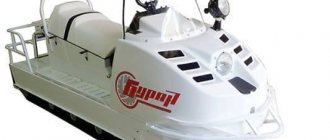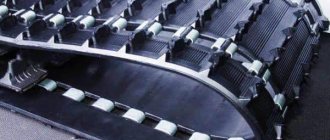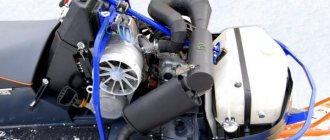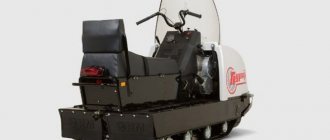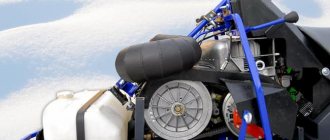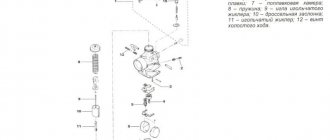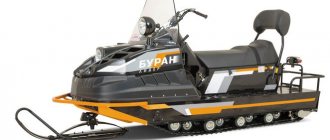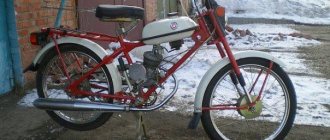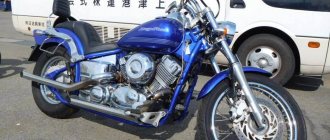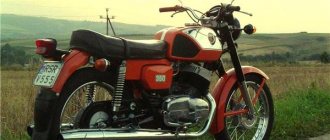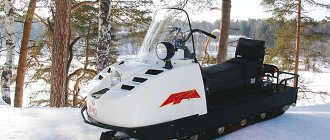RMZ-640 "Buran" is a push-pull configuration. Contains a crank-chamber purge equipped with a carburetor. Contains a two-cylinder engine.
The purpose of the crank mechanism, which is the basis of the engine, is to convert the rectilinear reciprocating movement of the pistons into rotation of the crankshaft.
In this article, each gearbox part will be considered separately.
Crankshaft device
The three-bearing crankshaft includes 46 journals on the right side and 23 journals on the left side, 8 jaws with a crank pin and 49 middle shafts, the connection of which is ensured by press fits. The mechanism is supported by three ball bearings, which are mounted on the middle shaft and journal journals. The rings, located in the grooves of the races on the outside of the bearings and labyrinth-type seals, are designed to equalize the loads placed on the crankshaft support bearings.
The movement of the part along the axis is supported by the stop of bearings directed into the retaining rings. They are located in certain grooves in the crankcase. The sealing of the ends of the part is ensured by a spiral bracelet spring.
Connecting rods
The engine connecting rod serves to connect the piston to the crankshaft. The main component of the part is the head located on top, as well as the crank head located below. They are connected by a rod with an I-section.
The engine connecting rod includes an upper and lower head provided with holes. They are equipped with needle bearings. The radial clearance indicator ranges from 0.012 to 0.024 mm. The clearance is ensured by sorting by diameter (based on different sizes of bearing rollers, piston and crank pins). The group marking is indicated on the stem part under the head. The holes located under the connecting rod serve as lubrication for the bearings.
Tuning and test drive
You can find many video reviews of Leader test drives on the Internet. In them you can clearly see the appearance and main functions of this snowmobile track. Not to say that Buran has advanced characteristics, but it lends itself well to tuning. There are a number of companies that assemble special tuning kits. Often, when purchasing such a kit, the owner of a snowmobile can save a lot of money.
Engine and chassis tuning
A typical tuning kit includes:
- Honda engine with two cylinders, 22 hp. With.;
- Arctic regulator with four cams;
- battery with a reserve of 24 ampere-hours;
- bumper bumper;
- soundproofed hood;
- cable for the engine (fastening).
In addition, you can improve the brake system of the track by installing a lightweight spring.
It is not necessary to completely change the engine. It is enough to order separately some of these components. The finished tuning kit includes. DD races with cuffs, bearing with piston pin MAHLE KONIG (Austria), original ALMET pistons made in the Czech Republic.
In addition to upgrading the engine, you can install a pair of new Polarnik tracks with a roller balancer, a driven shaft and a pipe-type oiler.
Appearance tuning
In addition to upgrading the driving properties, the owner can also improve the appearance of his truck. The design of the snowmobile allows you to install a modern on-board computer that will display speed, revolutions and engine temperature. This will allow you to expand the capabilities of the all-terrain vehicle, making it similar to more expensive imported models.
An updated hood will make the truck more attractive. You can improve night lighting, add LED bulbs, change the base color. Installing a winch will not only make the car more aggressive, but also add functionality to it.
Piston rings
The engine design contains pistons. They don't replace each other. They are equipped with a pair of piston rings, the basis of which is wear-resistant cast iron. The scheme can use a retaining ring with a cross-section in the shape of a trapezoid and a rectangle.
There is a thermal gap at the back of the ring. During operation, it is subject to expansion from heat. After installation, the gap diameter for rings with a trapezoidal cross-section is from 0.40 to 0.55 mm. To obtain these dimensions, it is possible to file the end parts of the lock.
The gap between the ends and grooves when compressing the ring to a diameter of 76 mm should be equal to 0.06-0.15 mm for a trapezoidal section and 0.080-0.115 mm for a rectangular section.
The retaining ring operates at high temperatures. Oil entering the gap between the hot ring and the piston groove is subject to coking. In other words, soot formation occurs and resinous substances are deposited, which causes the rings to burn. This contributes to a deterioration in starting performance and a decrease in the power level of the unit.
If carbon deposits are not removed in a timely manner, the device may deteriorate. The upper ring has a greater tendency to burn. Burning is usually caused by engine overheating due to improper use, as well as due to failure of the cylinder and ring.
additional characteristics
- Buran's tracks are 2. This makes its movement similar to tanks - it goes straight ahead. Withstands movement through small ravines, as well as rough snowy terrain;
- The snowmobile has only one ski. It is quite short, located in the bow. Often, tuning a Buran snowmobile comes down to improving this particular element (for example, adding additional cutters);
- The blizzard is quite heavy. Even its dry weight (without cargo, passengers and refueling) varies between 290 – 310 kg;
- The seat is double. Equipped with a passenger backrest;
- A molded windshield with a fairly powerful halogen headlight is installed in the nose of the Buran snowmobile. Also, all control and monitoring elements (lights, sensors and cigarette lighter) are located on the steering wheel. For complete comfort, all this is connected to a heating circuit;
- Combined lubrication. That is, when it reaches the parts, the oil is mixed with gasoline. Some models are equipped with a mechanical pump.
Cylinder structure
The cylinders do not replace each other. They are based on an aluminum jacket into which a cast iron sleeve is pressed. To ensure selective assembly of the liner-piston interface, the cylinders are manufactured in three sizes. Indicators are marked with the letters “M”, “C”, “B”. They are applied by impact to the flanges of the cylinder flange located below. When replacing a cylinder, a part of the same size is installed.
The cylinder is installed on the crankcase with the lower flange. The cylinder head is installed on the flange located on top. An asbestos gasket is placed between the head and the cylinder. When overhauling the unit, this gasket can be reused.
The joint between the lower cylinder flange and the crankcase supporting plane is sealed using paronite. Each crankcase is secured to the cylinder with four studs.
Operating instructions (Buran Leader ADE and K)
The user manual contains information on the general appearance of models A, AD and ADE, their design and maintenance of the main units. At the end, the owner can find a table with a list of typical faults, as well as methods for eliminating them.
Types and frequency of maintenance
Maintenance is an important component of the operation of any technical device. Snowmobiles require special attention because they are used in harsh conditions. In order for the engine and main components of the track to work properly for a long time, you need to properly care for them.
There are several types of maintenance, which include a number of specific activities. Depending on the frequency, they can be classified into the following types:
| Daily (DU) | This is done every time before leaving and upon returning to the garage. |
| Maintenance after break-in | Performed after 250-350 km. |
| TO-1 | Every 950-1050 km. |
| TO-2 | Every 2000 (± 50 km). |
| Seasonal (SO) | Preservation at the end of the season or before a long storage period. Also carried out after re-preservation during commissioning. |
The attached manual contains a table indicating the names of maintenance operations and types. The “+” sign indicates actions that must be performed during a particular type of work. Below is more detailed information about the operations carried out regarding maintenance:
- engine;
- chassis;
- hydraulic brake system;
- electrical equipment;
- control mechanisms.
It also provides recommendations for lubrication, break-in and daily maintenance.
Daily maintenance
The main task of the EO work is to prevent the departure of a faulty snowmobile. It includes a number of mandatory operations:
- checking the fuel level in the tank and oil in the reverse gearbox;
- inspection of the tracks, skis, springs and towing device;
- checking the serviceability of the steering, brake system, gear shift lever;
- diagnostics of engine idle speed;
- inspect the lighting system to ensure that the wires are completely insulated;
- checking the availability of spare parts and repair equipment.
In addition, it is necessary to check the presence of gasoline and oil leaks and the reliability of the fastenings. When diagnosing malfunctions, you should fix them yourself or contact a specialized service center.
Cylinder head design
The cylinder heads are based on an aluminum alloy. The base of the combustion chamber head is equipped with a threaded hole for mounting the spark plug. To avoid deformation of the head and cylinder, the stud nut should be tightened crosswise twice when assembling. First, preliminary tightening is carried out, and then final tightening to 2.0-2.5 kgf-m.
It should be noted that the exhaust manifold nuts must be secured first. Tightening and tightening of the nuts is carried out on a cold unit.
The principle of operation of the sensor for measuring engine temperature on the Taiga 500 Snowmobile
The operating principle of most sensors is the same as on Soviet-made snowmobiles:
- Under the glow plug there is a ring with a thermocouple inside.
- The signal from this element comes to a device that controls the temperature.
On the Lynx snowmobile there is a threaded hole on the cylinder into which the indicator is screwed.
Other models of similar equipment do not have such holes - they need to be drilled in order to install the sensor. If the snowmobile is under warranty, then this solution is not the most successful - this could result in losing the warranty.
If the snowmobile is water-cooled, then it is possible to install a metal pipe with a thread, which is built into the cut hose of the cooling system.
On the Taiga 500 snowmobile, a temperature sensor (CITD-5 TPT-3-6U) is installed under the spark plug.
This solution is relevant for any motorcycle.
Using CITD 5, you can identify not only the engine temperature, but also other important indicators:
- Broken fan belt.
- Air inlet clogged with snow.
- Based on the temperature difference (between the cylinders), determine malfunctions in the fuel supply or spark formation, air leaks and engine overload.
High temperature is the cause of the above malfunctions, and the snowmobile owner should not only be alert to it, but also look for the reasons for its occurrence.
a brief description of
Brief characteristics of the device:
- Range minus 50 – plus 250 °C.
- Critical (at which a signal about engine overheating is given) - 195°C.
- The error is 2 degrees, no more.
- The device is intended for both snowmobiles with and without batteries (AC or DC). Voltage – 12V.
- Ambient operating temperature – minus 50 – plus 50 °C.
- The case is made in size 45×93 cm.
- There are two LED indicators that display the temperature of each cylinder individually.
- The device is controlled from a multifunction button.
When the temperature of one or both cylinders reaches 195°, the display displays the temperature up to the measurement limit (250°C) in pulsation mode.
This signal from the indicators indicates that the critical temperature is approaching.
How to install the device
In order to install the CITD 5 device, you need to embed it into the panel. The housing is protected from falling out of the cut-out window by means of L-shaped brackets secured with screws.
Carter
The crankcase acts as the main body part of the engine. It consists of two parts, which are made of aluminum. The halves are attached to each other by means of pins screwed into the upper part. The fastening nuts are tightened with a torque value of 3.0-3.5 kgf-m.
Both parts of the crankcase are processed in parallel and therefore do not replace each other. Each cylinder head is secured to the crankcase by means of four studs, which are screwed into the threads of the support flange. The part's parting planes are coated with sealant.
The ends of the crankshaft that exit the crank chambers are sealed with movable collars. The crank chambers are insulated using labyrinth seals installed at both ends of the middle support bearing.
Chassis
The snowmobile has one steering ski and two rear tracks. Thanks to this, the car is not afraid of stumps, snags, bushes and tree branches that can cause damage to the chassis. The use of exactly two tracks had a positive effect on the vehicle’s maneuverability, since their total area ensures low specific pressure.
Another key point is maneuverability. With this, everything is great with Buran, since one swivel ski, combined with a fairly short longitudinal base of the equipment, allows you to maintain nimbleness in rather cramped conditions, for example, to easily go around trees in forest areas. The modernized frame, which received a front bevel in the tunnel, coupled with increased ground clearance, allows you to easily move through deep snow.
It should be emphasized that the Buran A snowmobile is very simple and unpretentious in further maintenance. Spare parts are easy to find. The machine has excellent maintainability even in field conditions far from civilization.
How is the engine cooled?
For an engine system in operation, the temperature of the heads should not exceed 200 °C.
Since the unit is closed by a hood, its cooling by air flows through the grilles is not enough to maintain the temperature level at the required level. To solve this problem, an air cooling system is used, consisting of an axial blower fan and a blower casing.
The basis of the fan is the impeller, which is mounted in a stationary position on the roller. In the housing, the impeller is mounted on a pair of ball bearings, which have a double-sided seal. They are filled with working lubricant at the factory.
The impeller operates with the assistance of a V-belt from the drive pulley. It is secured with three studs. At the end of the roller there is a driven pulley, which consists of a pair of profiled half-pulley disks. The pulley fastening nut was tightened with a torque of 5-6 kgf-m.
The housing is mounted on four flange studs to the right of the crankcase. A plastic air intake device is mounted at the fan inlet. The belt is tensioned by rearranging the adjustment washers, which are located between the half-pulleys.
The top of the corner of the stream is shifted from the center. Thus, it increases the diameter of the driven pulley and the belt tension. When using the engine, you must constantly check the tension of the fan belt. Under a force of 4±0.5 kgf, the belt bending rate should be 6-15 mm. A very weak tension indicator causes the belt to slip at high speeds. Its delamination from heating and strong tension damages the impeller bearings. Lubricant should not be allowed to come into contact with the belt, as this will cause its destruction and cause malfunction.
How to Measure Snowmobile Engine Temperature
It is necessary to monitor the operation of the engine. Need to:
- Listen to the engine running.
- Monitor his temperature.
In order for the mode to be maintained at the desired level, all snowmobiles have a cooling system. It is better to control it using a special temperature sensor.
This is especially important to do on two-stroke engines.
Not all snowmobiles have sensors installed from the factory; therefore, on many it is highly recommended to install them yourself or in a workshop.
So, when a digital display is displayed on the dashboard, you can control the fairly accurate temperature of each cylinder.
What measures are taken to increase the power of the device?
To increase the power level of a device such as the RMZ-640 gearbox, it is recommended to carry out the following manipulations:
- Replace the crankshaft oil seals with other modifications (take the oil seal from Moskvich-412).
- Make a new oil seal housing using material D16T or its equivalent.
- Drill additional channels for ventilation.
- Install an additional pair of medium bearings instead of one on the crankshaft between the middle flywheels.
- Install deflectors between the cylinders at the air outlet.
- Balance pistons with a weight difference of no more than 1.5 g.
- Provide thermal insulation of the exhaust manifold using asbestos cord.
- Align the cylinders in height so that the edges of the exhaust and intake ports of the cylinder coincide with the edges of the skirt and piston bottom. This way the air release phases on both cylinders will coincide.
- Install a resonant pipe with a noise barrier.
How to improve the functionality of the crankcase?
The reason for the deformation of the crankcase is the weakness of its rigidity and the large cantilever of the crankshaft between the three supports. This causes increased stress on the bearings, which without proper lubrication contribute to increased resistance, rolling and friction.
The same effect is caused by the bearing retaining rings from the displacement of the crankshaft in the crankcase. In this case, the bearings have no clearance. When heated, the crankshaft expands, but there is no necessary clearance, so the bearing jams. The crankshaft begins to overheat and is unable to develop the required speed. For optimal functioning of the part, a pair of bearings should be mounted, and an oil seal should be installed between them.
Vibration of the shaft consoles without the necessary lubrication causes abrasion of the crankshaft seals. Overheating causes them to harden. The result is air breakthrough through the oil seal and a lean mixture of fuel and air in the engine crankcase. The consequences will be very dire - the piston will burn out or its bottom will melt. The RMZ-640 device will jam.
What is the critical engine temperature of the Taiga snowmobile?
When the engine temperature exceeds 200 degrees, there is a high probability that the engine may undergo irreversible physical changes, which will result in expensive repairs. The critical engine temperature of the Taiga Varyag 550V snowmobile, as well as the 550 model, is no different.
However, the same 200 degrees are acceptable, but only for a short time.
The consumer should have an idea of what operating temperature the engine should be on the Taiga snowmobile.
You should not skimp on high-quality oils - this will significantly extend the “life” of the engine.
Functionality check
You can check the functionality of the sensor after purchase even before installing it on the snowmobile. Subsequence:
- Connect the device to the battery.
- Heat the sensor in any way. For example, using a construction or even a regular hairdryer.
Of course, it would be more correct to subject the sensor to the maximum specified heating of 250 degrees in order to finally verify its serviceability.
How to solve the problem of unbalanced piston operation?
The difference in the weight of the pistons by an average of 20 g is caused by insufficient thought of the parts of the unit. Such an imbalance becomes the culprit for disrupting the smooth and stable operation of the engine, which causes a high level of vibration. To adjust the weight of the piston, remove the excess metal layer from the inside of the skirt and adjust the size of the bypass window in the skirt to the cylinder windows (their coincidence must be achieved). It is necessary to round off the radii at the ends of the windows, as well as dismantle chamfers with a radius of 0.5 mm.
An important role is also played by the fact that the correct installation of the intake and exhaust phases of the air mixture influences the coherence of the cylinders and the reduction of engine vibration. This is quite easy to do. An additional gasket should be placed under the cylinder, which is located below. It will be better if the bottom of the piston coincides with the lower edge of the cylinder port at the outlet. It is recommended to install a resonant tube and muffler.
By adjusting the carburetor and making some improvements in the electronics and ignition, you will get a unit whose operation will be stable, uniform and economical in fuel consumption. The temperature indicator at maximum speed under the spark plug of the cylinder located at the rear fluctuates within 190 °C. The crankshaft speed of the unit during takeoff ranges from 4700 rpm to 5200 rpm.
BURAN ENGINE: UNLOCKING RESERVES
The engine ran on fuel consisting of a mixture of AI-93 gasoline (specific gravity 0.74) and MGD-14M oil in a ratio of 1:30. Fuel flowed by gravity from a supply tank installed at a height of 2.5 m relative to the carburetor.
Before the tests, the valve timing was checked, the effective compression ratio was clarified - it amounted to Eeff = 5.6. The low value of the average effective pressure of the serial engine was noted - only 3.56 kg/cm2.
All operations associated with taking characteristics were carried out on a complex engine stand, manufactured in the aviation department of the Scientific and Technical Institute and which made it possible to simultaneously record the values of torque, fuel consumption, speed and temperature of the cylinder heads.
The stand includes a balancing machine, a moulinette (a wooden propeller with a diameter of 840 mm), a fuel flow meter (stichprober) with sealed contacts (reed switches), a thermocouple with a dial indicator and a consumable fuel tank with a capacity of 10 liters.
To change the moment of resistance, six pairs of replaceable brake plates were attached to the ends of the moulinette blades, which made it possible to obtain seven measurement points for external characteristics.
The measuring base of the probe consisted of three volumes controlled by reed switches, a magnetic float and three-way valves. Electronic tachometer - non-contact, with an induction sensor. The temperature meter is an aircraft type that records the temperature of the cylinder heads under the spark plug.
To reduce friction forces, all moving joints of the machine are equipped with rolling bearings.
The work was carried out in four stages:
1) taking the initial (control) characteristics of a production engine;
2) modernization;
3) taking characteristics of the modernized engine and checking it on a trike;
4) characterization of a modernized engine without a blower and gearbox.
The first stage was carried out on a complex engine stand.
Rice. 1. Units and parts of the serial engine RMZ-640 “Buran”, which were newly manufactured or modernized.
Rice. 2. Modified inlet (a) and outlet (b) windows of the cylinder (the surface of the cylinder is rotated in the plane of the drawing).
Rice. 3. Modified piston (the surface of the piston is rotated in the plane of the drawing).
Rice. 4. Displacers in the crankcase:
1 — crank chamber; 2 — displacers (AMg-6); 3 — M4 screw (20 pcs.).
Rice. 5. Displacers on the crankshaft:
1 - crankshaft; 2 — displacers (glass reinforced with epoxy binder); 3 — holes (d4 drilling to a depth of 0.5 mm, 20 pcs.).
Rice. 6. Cuff block:
1 — holder (anodized D16T); 2 — sealing ring, rubber (from VAZ-2108); 3 — cuff (from VAZ-2101, trimmed).
Rice. 7. Valve box:
1 — plate valve (2 pcs.); 2 — box body (AL1); 3 — cover (AL1); 4 — M5 screw (8 pcs.).
Test conditions: outside temperature +2°C; atmospheric pressure - 746 mm Hg; fuel - a mixture of AI-93 gasoline with MGD-14M oil (1:30); carburetor - K-62Zh (main jet diameter - 1.36 mm; effective compression ratio Eeff = 5.6); candles - A17DV.
The following results were obtained.
Propeller characteristics (external load - propeller diameter
1.6 m and 0.79 m pitch): Ne = 25.8 hp. at 5086 rpm, Ce = 0.433 kg/h hp.
External characteristic (external load - moulinette): Ne = 27.9 hp. at 5514 rpm, Ce = 0.416 kg/h hp. Head temperature t°C = 212°C.
The second stage is the modernization itself. Subject to modification; crankcase (displacers are installed in the corners of the crank chamber), cylinder heads (the supporting surfaces of the heads are cut to
1.8 mm to increase the effective compression ratio, Eeff increased to 7.2, the cylinders themselves (the intake and exhaust windows were bored out), the crankshaft (displacers are installed in the grooves of the cheeks), the cuffs of the crankshaft main journals (cut by 1 mm). The carburetor diffuser was also bored out to a diameter of 33.6 mm, the diameter of the main jet was increased to 2.12 mm, and the height of the nozzle was reduced by 0.76 mm.
The valve timing (intake and exhaust) is increased. Each cylinder has two additional bypass channels with phases equal to the phases of the main channels (the cylinder liner was not pressed out).
Newly made; pistons, valve box, box cover, check plate valves (plates, seats and stoppers), cuff races.
The pistons are forged from AK12D alloy. They have two purge windows, which reduced the temperature of the upper rings and piston heads and eliminated their burnout.
Unlike the serial one, the skirt of the new piston is barrel-shaped and elliptical in accordance with the temperature gradient. The geometry of the skirt was adjusted experimentally. Since this process is quite complicated, you can leave the standard pistons, modifying them according to the attached drawings.
The body and cover of the check plate valve box are cast from AL1. However, it is possible to use any other cast heat-treatable aluminum alloy.
Valve seats are made by pressing from organite (or Kevlar, as this SVM is also called - ultra-high-strength material) on an epoxy binder, heated to 80-85 ° C during the polymerization process. The dimensions of the saddles with minor changes are taken from the book by V.M. Kondrashev and others (see Literature). The material of the valve plates is STEF-1 fiberglass, the limiters are steel.
Since the placement of valves and boring of the cylinder windows increase the volume of the crank chamber of the crankcase by 41 cm3 (which leads to a decrease in the purge pressure and, as a result, a decrease in the maximum engine power), so-called displacers are installed in the recesses of the crankshaft cheeks and in the corners of the crank chamber harmful volume. On the crankshaft, they are made of glass fiber with an epoxy binder (for better adhesion of the winding to the cheeks, a drill with a diameter of 4 mm is marked in them with holes 0.5 mm deep). In the crankcase, the displacers are aluminum half-rings of triangular cross-section, attached with M4 screws.
The sum of the displaced volume in the chamber, together with the volume displaced by the cuff holder, is 79 cm3, which more than compensates for the increase in volume from the placement of valves and boring of windows, which ultimately improves purging.
However, the increase in pressure in the crankcase led to the fact that the standard cuffs began to be squeezed out of the clips. This was discovered during the first engine starts. I had to make new clips and install in them the cuffs from the axle shafts of the VAZ-2101 car, cut by 1 mm and facing each other with their front sides. To seal the clips, rubber rings from the ignition shaft from the VAZ-2108 car engine were used.
Rice. 8. Plate valve:
1 — valve seat (organic or Kevlar); 2 — M3 bolt (4 pcs.); 3 limiter (steel, 2 pcs.); 4 valve plate (fiberglass STEF-1, 2 pcs.).
Before installing the cuffs, the clips were heated to 200–250°C. Then, CIATIM-201 lubricant with molybdenum disulfite was filled into the cuff cavity, after which the races were mounted on the crankshaft. Their shoulders are tucked into the crankcase recesses, and the standard thrust rings are removed.
In addition to these works, the usual procedures for refining internal surfaces for two-stroke internal combustion engines were carried out, that is, cleaning the casting in the channels and windows and adjusting the interface lines between the crankcase and cylinders. More details about this in the book by I. Grigoriev (see Literature).
Third stage. During repeated tests, the parameters of the external, screw, and flow characteristics and the maximum temperature of the cylinder head under the spark plug were measured. The temperature and composition of the exhaust gases were not indicated. The power was brought to normal conditions. The ignition system has not been changed or adjusted.
Test conditions: outside air temperature - 8°C; atmospheric pressure - 748 mm Hg; fuel and external load are the same as before modernization; the carburetor diffuser is bored to a diameter of 33.6 mm; main jet - up to a diameter of 2.12 mm; Eef = 7.2.
Test results of the modernized engine.
Screw characteristics: Ne = 31.7 hp. at 5316 rpm, Ce = 0.321 kg/h hp; head temperature t°Cmax = 204°C; increase in power - 22.8 percent, efficiency - 25.8 percent.
External characteristics: Ne = 38.2 hp. at 5778 rpm, Ce = 0.332 kg/h hp. Head temperature - t°Cmax = 208°C; increase in power - 36.9 percent, efficiency - 20.25 percent.
And finally, the fourth stage. In the configuration without gearbox and blower, the engine spun up to 6840 rpm, the recorded power was 19.6 hp, Ce = 42.2 hp. at 5978 rpm, Ce = 0.338 kg/h hp.
To match the characteristics of the modernized engine, a new propeller with a Wortman profile RX-63-137 with a diameter of 1.6 m and a pitch of 0.8 m was designed and manufactured for a flight speed of 72 km/h. With it on the mooring lines, a thrust of 152 kg was obtained. Before this, the mooring thrust of a serial engine with a standard propeller reached 112 kg, after modernization - 135 kg.
The rate of climb of a two-seater trike with a serial engine and a standard propeller was 1 m/s. After modernization, with the same propeller, - 2.5-2.8 m/s; and with a newly manufactured one - 3-3.2 m/s, while the hourly fuel consumption did not exceed 9 liters.
The temperature of the “hot” cylinder head of the modernized engine when operating in takeoff and climb mode at an outside air temperature of +28°C did not exceed 195°C.
Result: after completing the above stages of modernization, engine operation became smoother and softer, and starting was much easier. Almost all of its main characteristics have improved: power, efficiency, continuity and, most importantly, reliability. At the end of September 1999, the engine had operated in hang-glider flights for 32 hours without any problems.
V. NOVOSELTSEV
LITERATURE
1. Kondrashev V.M., Grigoriev Yu.S., Tupov V.V., Sillat P.P., Abramov V.I., Strokin A.N. Two-stroke carburetor internal combustion engines. - M., Mechanical Engineering, 1990.
2. Grigoriev I.M. A motorcycle without secrets. - M., DOSAAF, 1973.
We recommend reading
- HAD NO EQUALS The appearance in the artillery of the Red Army in the mid-30s of high- and especially high-power guns (calibers from 152 to 305 mm) acutely posed the task of creating a large tractor for them with...
- MODEL CONSTRUCTION 1990-05 CONTENTS: Issue report: A. Fehringer. Taking care of the earth (1). Public design bureau "M-K": Quasi-car boat (2). Small mechanization: A. Kopyev, P. Kopyev. Microtractor for your...
Here you can evaluate the author's work:
How to make improvements in the field of electronics and ignition?
- The screws securing the Magdino iron plates to the magnets must be made of brass. Their fastening must be reliable. If even one small screw is loosened, the operation of the unit will be disrupted.
- Magdino balancing must be of high quality. It is also carried out after factory settings, as it promotes optimal vibration. The fan for blowing also requires good balancing.
- The coil leads must be soldered. Their screws must be made of stainless steel or coated with oxide. Before tightening them with a tap, it is recommended to improve the condition of the threads in the stationary part of the magdino. A lot of debris remains on the tap. This is the cause of poor grounding. The contact points of the coil leads with the fastening screws also need to be soldered.
- After screwing the coils to the base of the magdino, all contact areas and soldering must be covered with sealant.
- It is recommended to bring out an additional wire to ground the ignition coil under the spark plugs.
- High-voltage wires are not taken from an old car. For example, NGK series candles are suitable.
- Ignition should be carried out according to the factory mark. The mounting bolts must be well tightened to maintain the ignition angle.
- If you add a gear reducer with a gear ratio of 2.2-2.6 m to the design of the Buran engine and supplement the unit with a two-blade propeller 1.65-1.8 m or a three-blade model 1.45-1.6 m, then you can get high-quality traction that is stable.
Sensor cost
The cost of the CITD with sensors for snowmobile spark plugs is up to 7 thousand rubles. This is the factory price.
The length of the wire (including spark plug cables) is 2.4 meters, and if necessary, you can increase it yourself.
The device is supplied with everything necessary for installation.
The warranty is 12 months and the minimum service life is 5 years.
Technical characteristics of CITD 5
| Temperature range | -50…+250°С |
| Permissible measurement error | ±2°С |
| Overheat alarm temperature | 195°С |
| Number of sensors | Engine temperature sensor - 2, outside temperature sensor - 1 |
| Rated voltage (DC or AC) | 12V |
| Permissible voltage deviation from nominal | ± 3 V |
| Power consumption | 1W |
| Operating temperature | -50 .. +40 ºС |
Choosing between two models
Quite often, consumers are faced with the question: is the Taiga Varyag 500 snowmobile or 550? Both models are very popular.
In order to answer this question correctly. The characteristics of both models should be studied.
Technical characteristics of "Taiga Varyag 500"
- 2-cylinder engine with a volume of 503 cm3
- Air cooling
- Reliable and advanced carburetor “RMZ 500”
- Fuel system - “MIKUNI” (Japan)
- Electronic ignition from DUCATI (Italy)
- Two seats - driver/passenger (the model was planned to be single-seat)
- Chassis - shock absorbers. Stroke – 115 mm (previous – 150 mm)
- Heated grips
- Ergonomic tubular steering wheel from the Tiksi snowmobile
Not included in the standard configuration:
- Electric start
- Separate lubrication system
Technical characteristics of "Taiga Varyag 550"
"Taiga Varyag 550" is equipped with components suitable for the climate of Siberia, the Urals, and the Far North.
Technical characteristics of “Varyag Taiga 550V” (what has been added):
- Telescopic suspension "Bars 850". Stroke – 277 mm.
- The front suspension is equipped with a horizontally mounted shock absorber to facilitate movement on uneven roads. This added energy consumption.
- The tracked ground hitch has been modernized. This improved cross-country ability, dynamics at high speed and when braking, as well as maneuverability.
- The high handlebar improves both ergonomics and appearance.
Thus, this “Varyag” comes with improved equipment, but is not a source of competitive advantages.
Equipment of the original device
The original RMZ-640 units are filled with pistons and piston rings produced in the Czech Republic. Needle bearings are produced in Japan. In the fake RMZ-640 unit, spare parts are made in China. This unit does not have a high degree of functionality.
Of course, when purchasing a Buran engine, it is difficult to see how its mechanism is assembled, so it is recommended to pay attention to the following:
- The engine produced at the plant is supplied to dealers and stores in a branded cardboard box with the RM logo.
- The packaging must contain a company logo containing the serial number of the unit.
- The device must be accompanied by a technical passport. The number written in it must match the number indicated on the device itself.
- "Buran 640" contains raised "RM" logos in the body. Brand marks can be seen on the recoil starter housing or the fan housing.
- Pay attention to the base located under the motor. This part was removed from the RMZ-640 units that began to be produced after February 2013.
Characteristics of the main elements:
Chassis:
- caterpillar - reinforced with rods, rubber-fabric;
- propulsion unit – caterpillar with front-mounted main sprockets;
- caterpillar suspension – spring-hydraulic;
- frame – metal with a hinged hood;
Transmission:
- variator – automatic stepless V-belt;
- gearbox – 1-speed with reverse (speed switching – manual).
Control mechanisms:
- brake system – disc friction mechanical type with manual drive;
- controls - motorcycle-type steering wheel.
Electrical equipment and measuring instruments:
- electric starter;
- headlight;
- accumulator battery;
- speedometer – SP158 (daily and total mileage).
Difficulties in operating the engine
The unit, specially created for a snowmobile, has a high level of functionality. This article discussed the main characteristics of the RMZ-640 engine.
Currently, the working condition of the units that are in operation is ensured by the purchase of parts and do-it-yourself repairs. A big disadvantage that complicates the use of this device is the shortage of spare parts. They are mainly obtained in Rybinsk, since the gearbox is used for the Buran snowmobile. Also a big omission is that no special literature on the use, repair and maintenance of the product was published.
Video
The equipment was tested in various regions. The main tests took place in Yakutia, where the model performed very well. The improvements made in the Lynx 440 modification improved maneuverability and maneuverability.
A snowmobile is intended for moving people or transporting goods off-road at temperatures from +5 to -40 degrees. The car confidently drives on the crust at high speed. The design of the snowmobile is simple, so even an inexperienced driver can operate it. Maintenance and repair of equipment is often performed at home or in the field. Similar qualities and excellent cross-country ability of the Lynx 440 model made it very popular among fishermen, hunters and consumers who need to move in difficult conditions.
Production of the snowmobile officially ended in 2009. However, many owners continue to actively use the model today.
Application of the unit in small aircraft
The modified design of the Buran RMZ-640 device is widely used in small aircraft. Many hobbyists purchase the RMZ “box” for spare parts. It costs seven times less than the specialized Buran-Avia gearbox. Cheapness is the main reason for using the RMZ-640 model.
Of course, the level of assembly and modernization depends on the skills of a particular person, but the use of the unit in aviation is not a positive trend. It leads to a regression in establishing the production of special equipment for aircraft at an affordable price.
Low-income and non-compliant aviation enthusiasts will not use a specialized engine as long as it is possible to assemble an analogue at a low price.
Repairs and breakdowns
According to reviews from owners, one of the most common and annoying breakdowns is a broken gearbox chain. Oddly enough, this is connected with improvements. New models are equipped with more “elegant” double-row chains with a reduced pitch (only 9.5 instead of the original 12.7).
Almost immediately during operation, frequent breakdowns and repairs of the Buran snowmobile gearbox began to be noted. Double-row chains with a pitch of 12.7 are rightfully considered the most reliable, but these can only be found on models of the 70s and 80s. In more modern models, there is a division into circuits of “old” and “new” samples (the pitch is the same at 9.5).
Unfortunately, today the gearbox is the weakest and most vulnerable component of the storm. Therefore, many people carry a spare chain with them. One of the additional solutions to the problem was the transition to imported three-row chains (the step is the same). They show a significant reduction in breaks due to an increase in the minimum loads that destroy the chain.
But there are also nuances here. Along with the chain, it is advisable to also change the shafts with gears. Worn parts (especially sprockets) will cause distortions, which will again lead to frequent breaks. In addition, many people also modernize the gearbox itself.
